It was just over a year ago, last October, that we acquired our baby Wild Boar. I had gotten a fence made in the meantime, as one of the requirements in our village to look after pigs is to have a fence. (Even so, I am pretty sure that we are the only ones who have ever followed that rule in its history.)
The fence was made of mangrove posts and the location of it was directly in front of our house, across our yard, where there was softer sandy ground for him to be able to root around in. It was about five feet by six feet, and also about five feet tall. The size of his fenced in area was actually quite a bit larger than any Tigak pig fences because Beth, being a animal lover, insisted the pig needed a decent amount of room to around and play a bit. 🙂 Just because we would eventually eat him didn’t mean we couldn’t let him have some fun while was living.
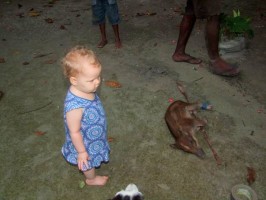 I forget who actually sold him to us, but he was very small and I paid K35, which was roughly $15 US. His legs were tied together using jungle rope, and he was ticked! We knew that it would take a week or so for him to get used to us and become tame, so we tied a rope around him, like a harness, and tied him inside our Haus Kuk. Then we untied the rope on his legs. He tried to run away, but it didn’t take very long for him to realize he wasn’t going anywhere.
I forget who actually sold him to us, but he was very small and I paid K35, which was roughly $15 US. His legs were tied together using jungle rope, and he was ticked! We knew that it would take a week or so for him to get used to us and become tame, so we tied a rope around him, like a harness, and tied him inside our Haus Kuk. Then we untied the rope on his legs. He tried to run away, but it didn’t take very long for him to realize he wasn’t going anywhere.
We named him “Jeff” after our good buddy back home, Jeff Schaap. Most people in the village, though, call him “Jep” because the “f” sound is foreign to the language.
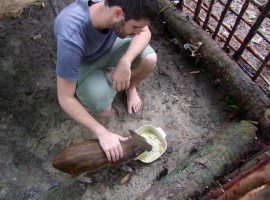 Unfortunately, because of how the rope was tied around his legs, he had a massive sore on one of his feet and was not able to walk on it very well. We had hopes that the sore would heal easily but in a few days his leg became very swollen and infected. Because of this we not only had to hold him very often to help him get used to us, but we also gave him antibiotics. This helped clear up his sore in no time. The first few weeks of caring for our little “Jeff” was a bit strenuous as we got used to making sure he had food almost constantly, held and pet him often and gave him his meds. Thankfully the effort quickly paid off as Jeff adjusted to us and learned to run to us as we approached instead of run away! Beth has “fond” memories of firmly holding the little guy against herself and walking around the village as he intermittently squealed his little head off in defiance of being tamed.
Unfortunately, because of how the rope was tied around his legs, he had a massive sore on one of his feet and was not able to walk on it very well. We had hopes that the sore would heal easily but in a few days his leg became very swollen and infected. Because of this we not only had to hold him very often to help him get used to us, but we also gave him antibiotics. This helped clear up his sore in no time. The first few weeks of caring for our little “Jeff” was a bit strenuous as we got used to making sure he had food almost constantly, held and pet him often and gave him his meds. Thankfully the effort quickly paid off as Jeff adjusted to us and learned to run to us as we approached instead of run away! Beth has “fond” memories of firmly holding the little guy against herself and walking around the village as he intermittently squealed his little head off in defiance of being tamed.
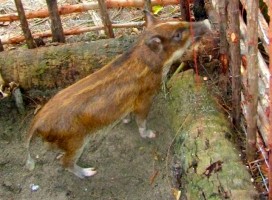 After he was tame, we took his harness off and moved him into his new home inside the fence. He was thrilled to be out of the harness, but not so thrilled to be caged in. In any case, he got used to it and we began a normal feeding routine with him.
After he was tame, we took his harness off and moved him into his new home inside the fence. He was thrilled to be out of the harness, but not so thrilled to be caged in. In any case, he got used to it and we began a normal feeding routine with him.
Feeding took place every night, when we gave him a bucket of food scraps and a bucket of water. Also, children from around the village would come and in exchange for gum or candy, they would scrape or cut coconut pieces for him to eat, which he loved. He also liked to eat banana leaves, papaya and the compost scraps Beth collected for him daily. Feeding him was kind of a pain in the neck, though, because every night if he didn’t get his food when he felt like he should, he would start squealing really loudly until I brought him his food. It was so loud, people in the village would come by and let me know he was hungry!
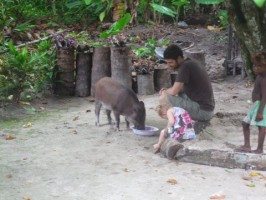 As he grew, people would often come by and comment on well he was growing. As he got bigger, they also began to comment that his man-parts would soon need to be “taken care of” if you know what I mean. 😉
As he grew, people would often come by and comment on well he was growing. As he got bigger, they also began to comment that his man-parts would soon need to be “taken care of” if you know what I mean. 😉
One morning I woke up and Jeff was missing from the fence. I searched all around for him and called out for him but he was nowhere to be found. The island is small so there is not a lot of places he could go. Also, he was now too big for any of the village dogs to mess with, and people don’t mess with other people’s pigs, so I wasn’t too concerned about his safety. I announced at our village-wide community meeting that he was missing and asked for help finding him. The next morning he was found hanging out with a bunch of lady pigs at a nearby hut, so we lured him back with a can of tuna, which was a treat he loved.
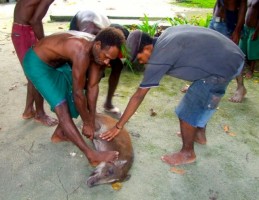 We knew it was time for him to get fixed. This would take care of his pressing desire to break down the fence if necessary to find a lady friend. The process of getting him fixed was… interesting. I won’t go into great detail but let me just say it involved three men holding him and one man with a razor blade. When the procedure was finished the area was doused with kerosene and he was sent back into his fence where I rewarded him with not one, but two cans of tuna. The sore healed on its own after a week or so.
We knew it was time for him to get fixed. This would take care of his pressing desire to break down the fence if necessary to find a lady friend. The process of getting him fixed was… interesting. I won’t go into great detail but let me just say it involved three men holding him and one man with a razor blade. When the procedure was finished the area was doused with kerosene and he was sent back into his fence where I rewarded him with not one, but two cans of tuna. The sore healed on its own after a week or so.
For the next two weeks two of his girlfriends would come by and hang out near the fence. I guess they learned after a while that it wasn’t happening any more…
It is important to fix your male pig, not only for your safety and for him to be fine with staying in his fence, but also because they grow much larger if they are fixed.
This was about the point when people started coming by with mouths watering, making comments about their excitement to eat him. Every day we were having people come by just to check and see how big he was getting.
He grew very well, and a few times he got out of his fence, but he always just hung around our area, knocking down banana trees and munching on their leaves. At one point a few months back, we put barb wire around his fence, not for him, but for the village dogs getting in to eat his food. This worked very well.
Well, in any case, to make a long story short, the time came when we made the decision that we needed to return to the States for Iris’ eye surgery. Among the many preparations that needed to be made, one was figuring out what to do with Jeff.
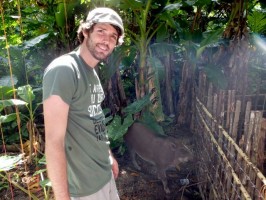 Although he was big, he could have gotten much larger. We needed to decide if we were going to ask someone to care for him, or sell him, or eat him. Asking someone to care for him would have worked, but we were not sure if we would be back in time to kill and eat him. Essentially this would mean whoever cared for him would be getting a free, large pig, which would be majorly disruptive in the village because of jealousy. So that option was off the table. As for selling him, we didn’t like the idea because we didn’t raise him to sell, and we felt like a lot of people had helped us raise him to eat and we didn’t want to let them down by selling him.
Although he was big, he could have gotten much larger. We needed to decide if we were going to ask someone to care for him, or sell him, or eat him. Asking someone to care for him would have worked, but we were not sure if we would be back in time to kill and eat him. Essentially this would mean whoever cared for him would be getting a free, large pig, which would be majorly disruptive in the village because of jealousy. So that option was off the table. As for selling him, we didn’t like the idea because we didn’t raise him to sell, and we felt like a lot of people had helped us raise him to eat and we didn’t want to let them down by selling him.
Originally, we were hoping that we could either eat him for a big village feast at Christmastime, or if we could wait until I was done with language study and host a feast in celebration. Now, because of going home and because my language learning timeline was longer than anticipated, it seemed like we would be changing those plans anyways.
So, we decided that we would eat him. We had many intentional conversations with Jude and Iris. Jude was horrified by the idea of killing and eating our pet pig but Iris happily agreed and agreed with me that he would taste “yummy”. We decided to have one last feast with the Tigak church before we left. This would be a more meaningful way for him to go out. I will not go into the story of how we butchered and feasted on “Jeff the boar” in this blog, look out for a follow up blog on that adventure later. 🙂
Honestly, it was fun to experience raising a Wild Boar, and was also culturally invaluable in terms of how it opened up relationships with certain people and what we learned from doing it. Having said that though, I don’t think I would do it again. It wasn’t a ton of work, but it turned out to be more than I expected. I don’t know… we’ll see.
Jeff the Boar with Jeff the Schaap
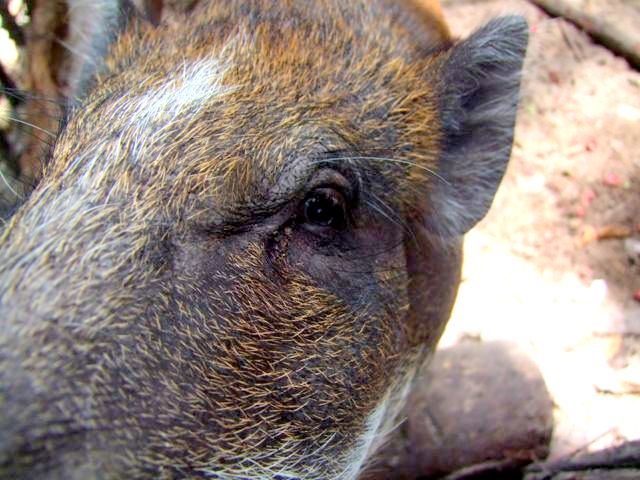
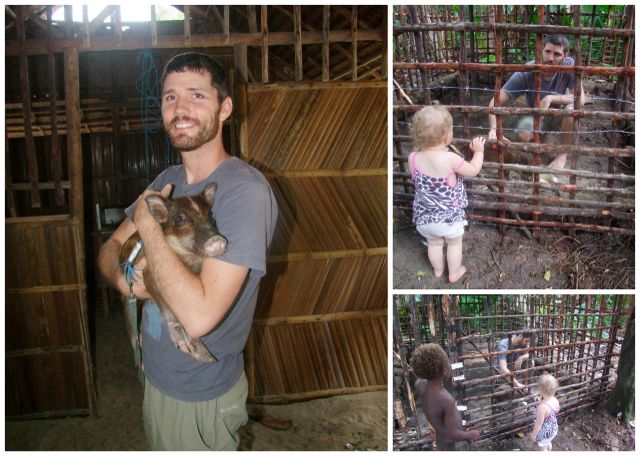
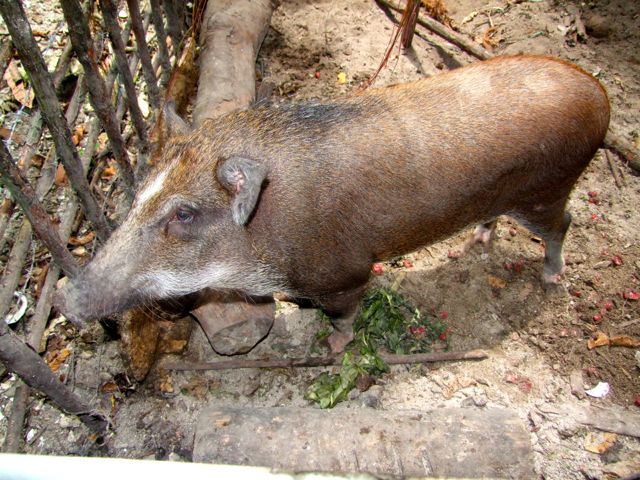
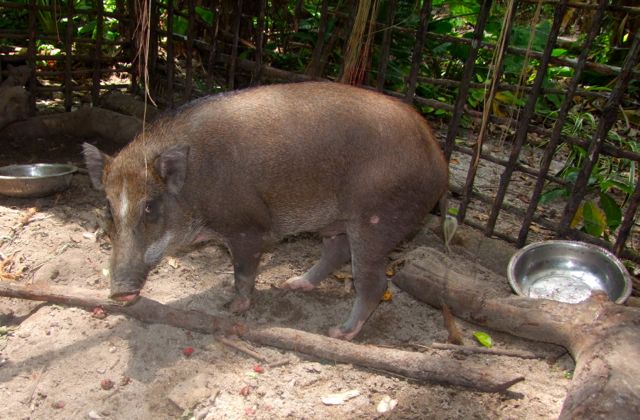
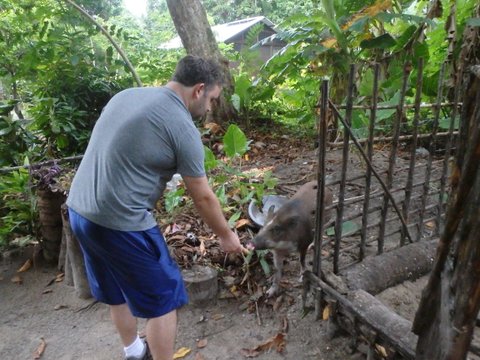
Leave a Reply